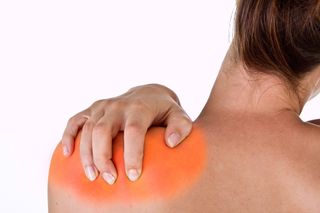Older Athletes Have Highest Risk of Shoulder Injury

Question: You can settle a bet for me. Who gets shoulder problems more often, athletes or seniors?
Answer: Athletes such as pitchers, tennis players and swimmers are especially susceptible to shoulder problems because of their repetitive overhead motions. However, shoulder problems are most likely to victimize people older than 60. You can deduce that, as a group, old athletes are at the highest risk of shoulder injury.
[Shoulder problems are so common among seniors that I am doing a two-parter on the subject. This is the first column.]
Let's start with some anatomy.
The shoulder is the body's most movable joint. It is also unstable because the ball of the upper arm is larger than the shoulder socket that holds it. In contrast to the hip joint, a conventional ball-and-socket, the shoulder joint is like a tee with a golf ball on it.
The unstable shoulder is held in place by soft tissue: muscles, tendons and ligaments.
Tendons are cords that hold the shoulder muscles to bones. Ligaments hold the three shoulder bones to each other. The three shoulder bones are the collarbone (clavicle), the shoulder blade (scapula) and the upper arm bone (humerus).
Sign up for the Live Science daily newsletter now
Get the world’s most fascinating discoveries delivered straight to your inbox.
Many shoulder injuries are caused by tissue breakdown. Common shoulder problems include dislocation, separation, torn rotator-cuff, frozen shoulder, fracture, arthritis, tendinitis and bursitis. The rotator cuff is defined as the set of muscles and tendons that secures the arm to the shoulder joint and permits the arm to rotate.
More than 7 million Americans go to a doctor with a shoulder problem each year. More than 4 million of these visits are for rotator-cuff injuries.
- Dislocation. Dislocation occurs when the ball at the top of the bone in the upper arm pops out of the socket. To treat a dislocation, a doctor pushes the ball back into the socket. Once a shoulder is dislocated, it may happen again.
- Separation. A shoulder separation occurs when the ligaments between the collarbone and the shoulder blade are torn.
- Torn rotator cuff. Age-related wear of tendons can lead to a tear. Repeated overhead motion can also damage the rotator cuff.
- Frozen shoulder. Movement is very restricted in people with a frozen shoulder. Causes of frozen shoulder are: lack of use because of pain, rheumatic disease, bands of tissue that grow in the joint, and insufficient lubricating fluid in the joint.
- Fracture. In the shoulder, a fracture or crack usually involves the collarbone or upper arm bone.
- Arthritis. The shoulder can be affected by osteoarthritis, a disease caused by wear and tear, and rheumatoid arthritis, an autoimmune disease.
- Tendinitis. In tendinitis of the shoulder, tendons become inflamed from being pinched by parts around the shoulder.
- Bursitis. The bursa is a small fluid-filled sac that helps protect the shoulder joint. If the bursa becomes inflamed, you suffer from bursitis.
[In the next column, we'll discuss diagnosis and treatment of shoulder injuries.]
If you would like to read more columns, you can order a copy of "How to be a Healthy Geezer" at www.healthygeezer.com
All rights reserved © 2012 by Fred Cicetti
More from the Healthy Geezer:
